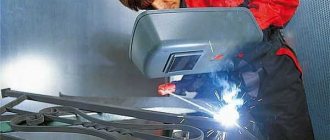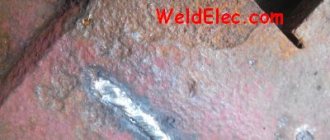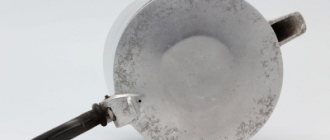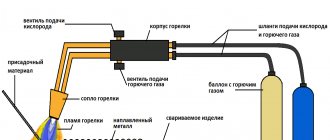The need for welding work often arises not only in production, but also in everyday life. Welding of aluminum products and structures at home is carried out quite often, despite the occurrence of some difficulties. The difficulties are due, first of all, to the characteristics that this material has. the conditions necessary for working with aluminum .
However, situations arise when it is necessary to repair aluminum products. In such cases, the work is performed at home, by the contractor’s independent efforts. Therefore, in this article we will look at the main features and nuances of aluminum welding.
Features of welding aluminum and its alloys
Difficulties in welding aluminum alloys and pure metal are associated with its properties:
- The melting point of the oxide film covering the surface of this material is 2044⁰C, and the melting point of the metal is 660⁰C.
- The surface of the droplets formed during the melting of aluminum instantly oxidizes, which prevents the creation of a monolithic seam. Therefore, the weld pool must be protected from contact with air.
- Due to the high fluidity of the metal in molten form, control over the weld pool is difficult. The problem is solved by placing iron plates under the workpieces to remove heat.
- Aluminum contains hydrogen, which, when the weld cools, comes out, forming pores and cracks. The alloys contain silicon, which promotes cracking as the joint cools.
- Aluminum has a high coefficient of thermal expansion, so shrinkage during cooling leads to deformation of the workpieces.
- Due to the high thermal conductivity, welding must be carried out with a current 1.5 - 2 times greater than when working with steel.
- When welding aluminum with your own hands, it is not always possible to determine the grade of the alloy, so setting the optimal welding mode is difficult.
Welding using specially coated electrodes
Electrodes with a special coating are used to weld aluminum structures, which are not subject to increased requirements for reliability and strength of the connection. Most often, this is the method used to weld aluminum with your own hands in home workshops. The main disadvantages of this welding method (it is used to connect parts whose thickness exceeds 4 mm) include:
- low strength of the weld, as well as its high porosity;
- intense splashing of molten metal;
- the separation of slag from the weld surface is quite difficult, which can cause corrosion of the latter.
Using coated electrodes and appropriate equipment, it is possible to weld parts from both technically pure aluminum and alloys of this metal. The most popular brands of electrodes, with which you can weld almost all types of aluminum alloys, are UANA and OZANA, which replaced the outdated OZA-1 and OZA-2.
Electrodes of the OZANA-1 brand are optimally suited for welding pure aluminum, and OZANA-2 - for joining workpieces made of alloys of this metal with silicon (AL-4, AL-9, AL-11).
Kobatek electrodes for welding aluminum alloys
Using such electrodes, welding work is performed using direct current, connected in reverse polarity, which should be taken into account when choosing equipment for performing work in industrial and home conditions. To select the value of the welding current, you can use a simple rule: 25–30 A direct current is required per 1 mm of electrode diameter.
When welding parts characterized by medium and large thickness, pre-heating of the parts being joined is necessary, for which you can use a gas torch. When it is necessary to weld parts of significant thickness, local heating of the future joint is performed. The use of preheating of parts (from 250 to 4000 - depending on the thickness of the metal), as well as slow cooling, allows you to effectively melt the metal even when welding at low currents, minimizing the risk of crystallization cracks and deformation of the finished structure.
Since aluminum electrodes melt quite quickly, welding work should be performed at high speed. It is very important to ensure continuity of welding carried out using one electrode. Breaking the arc in this case will result in the end of the electrode and the weld crater being covered with a slag crust, which prevents re-ignition.
It should also be taken into account that when welding aluminum, the electrode does not undergo transverse vibrations.
Slag should be removed as soon as welding is completed. Then you need to rinse the cleaned seam with hot water, and then treat it with a wire brush. This is done in order to remove slag residues from all corners of the seam (otherwise it can become a source of development of corrosion processes).
Welding using this technology is used primarily for work in home workshops and small repair shops. For such welding you do not have to purchase expensive equipment or consumables, but it is not recommended to perform important work with its help. What’s convenient is that you can even use equipment that you made yourself.
Aluminum welding methods
The choice of method by which you can weld aluminum at home is determined by the equipment available. Several methods have been developed, but only three have become popular.
Tungsten electrode
Aluminum is welded using this method when stringent requirements are imposed on the strength of the seam. It is created by melting a filler wire with a diameter of 1.6 - 4 mm by an arc created by a non-consumable tungsten electrode. To protect against oxidation, argon or helium is supplied to the welding site.
The work is performed on alternating current. If the work is carried out indoors, the gas flow is adjusted to within 5 - 8 l/min; outdoors it is more. The electrode diameter and current strength, depending on the thickness of the parts, are determined from the table:
| Electrode diameter, mm | Metal thickness, mm | Current value, A |
| 1 | 1 — 2 | 10 — 15 |
| 1,6 | 2 — 3 | 30 — 90 |
| 2 | 3 — 4 | 50 — 100 |
| 3 | 4 — 6 | 100 — 160 |
| 4 | 6 — 7 | 150 — 220 |
| 5 | 7 — 9 | 210 — 280 |
| 6 | 9 — 10 | 260 — 300 |
When performing welding, the nuances of the method should be taken into account:
- the arc length is maintained at 2.5 mm;
- the electrode is installed at an angle of 80⁰ to the joint;
- the wire is fed at an angle of 90⁰ to the electrode;
- the burner with the electrode is moved following the wire without transverse movements;
- To fill the joint evenly, the wire is fed in short sections;
- a ball of the correct shape should form at the end of the electrode; if not, you need to increase the current;
- the gas is supplied 4 - 5 seconds before welding the products, after completion it is turned off after 6 - 7 seconds.
Safety precautions
This type of activity belongs to the group of trauma-hazardous processes. Therefore, you should strictly follow the prescribed rules to avoid causing harm to others.
It should be remembered that:
- The specialist must wear: a special suit, a mask, thick gloves, shoes with rubber soles;
- The electrical circuit must be isolated and inaccessible;
- Welding can only be carried out in clean areas. It is prohibited to carry out work in the presence of flammable objects;
- The work area must have good ventilation to avoid gas poisoning.
Preparing surfaces for welding
Correct welding of aluminum means not only setting the process parameters, but also pre-processing the workpieces:
- The joint at a distance of 2 - 3 cm from the joint is cleaned of dirt and degreased with any solvent.
- When welding parts with a thickness of more than 4 mm with non-consumable electrodes, chamfers are removed from the edges at an angle of 45 - 65⁰. For sheets up to 1.5 mm thick, the ends are flanged. For workpieces connected by consumable electrodes to the coating, the edges are cut if the thickness is more than 20 mm.
- Before welding aluminum, the oxide film is removed from the surfaces near the joint with a file or wire brush. The treatment is carried out without pressure so that no particles remain in the scratches.
Necessary equipment
It is logical that to carry out work of this kind, the use of equipment is mandatory. First of all, it is necessary to ensure suitable conditions and prevent the occurrence of traumatic situations.
Moreover, it is necessary that this equipment helps control the energy transformation process.
For welding using gas, you will need an element with a gas supply, a cylinder with the necessary gas, a reducer and gas hoses.
Useful tips
Expert recommendations will help improve the quality of aluminum welding at home:
- when cutting edges, it should be taken into account that as the angle of the chamfers decreases, the width of the seam increases;
- when connecting parts with a thickness of more than 7 mm, a gap of 2 mm must be left between them;
- To ensure that the seam is even in width, the parts are first grabbed on both sides;
- before welding, the crack is widened and deepened, since welding aluminum without filling it is useless;
- Thick-walled parts are welded in several passes until the joint is filled, removing slag from each seam.
Having learned how to weld aluminum at home, you can move on to practice. However, in order to avoid becoming a victim of an accident, you first need to stock up on clothing and gloves made of fire-resistant material. To work at home, it is better to purchase a machine with the ability to carry out manual and argon arc welding.
Advantages and disadvantages
As mentioned earlier, welding aluminum is not an easy task and requires a certain skill and knowledge. However, this type of work is still in demand. The only explanation for this is the quality of manufactured parts and structures, despite belonging to the group of light metals.
Moreover, aluminum is so highly valued in industry that almost any tool necessarily includes this substance.
The advantages of cooking include the following:
- This process does not require much time, and the product of your activity can be seen a few minutes after the end of welding;
- This type of work is considered budget-friendly because it does not require the master to have any special equipment;
- Lack of a scale assessing the quality of the resulting seam;
- The result is a strong, seamless seam.
The disadvantages include the following:
- Despite the lack of criteria and requirements, the seam is still of poor quality;
- It is difficult to follow all the TB rules;
- From time to time, a specialist is faced with a problem in choosing auxiliary materials.
Work order
The sequence of operations for resistance spot welding of aluminum is as follows:
- Installation of blanks.
- Pressing materials tightly between the electrodes of a resistance welding machine.
- Energy supply through electrodes.
- Heating of parts.
- Formation of a molten core.
- Power outage.
- A short exposure of the workpieces between the electrodes in a compressed position in order to cool the welded zone and reduce the shrinkage cavity during crystallization of the molten metal.
The work process is automated and begins from the moment the operator presses the start button.











